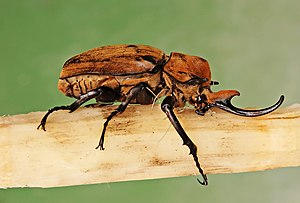Elephant beetle
| Elephant beetle | ||||||||||||
|---|---|---|---|---|---|---|---|---|---|---|---|---|

Elephant beetle ( Megasoma elephas ), male |
||||||||||||
| Systematics | ||||||||||||
|
||||||||||||
| Scientific name | ||||||||||||
| Megasoma elephas | ||||||||||||
| ( Fabricius , 1775) |
The elephant beetle ( Megasoma elephas ) is a kind from the family of scarab beetles (Scarabaeidae).
features
The beetle becomes very large, it can reach a body size of seven to twelve centimeters. It is colored black. The elytra, in the male also the pronotum and parts of the head, are covered with a dense fluff of upright, ocher yellow brooches ("vestitur") and thus appear covered in yellow. The body shape is very different between males and females ( sexual dimorphism ).
The male has two long, forward-curved horns on the leading edge of the pronotum. Two related species, long considered forms or subspecies of elephas , can be distinguished by the shape of these horns. In Megasoma occidentalis they are directed straight outwards, in Megasoma nogeirai they are bent forward. The pronotum is indented in the front half between the horns, the impression at the back is limited by a blunt edge with a blunt hump in the center. Further special formations characterize the head. This has a long, curved horn on the front (frons) that is 2.5 centimeters long. The horn is split sideways at the tip into two rounded corners. At its base there is also another horn-like hump, which is curved forward and covered with a yellow vesture. The legs are relatively long with long tarsi and thorny splints, the front splints are conspicuously curved inwards.
The female lacks horns and other special formations. Its pronotum has an uneven, bumpy ("rugose") surface, the label is also rugos at the base. In the middle of the pronotum sits a blunt bump or bump. With the exception of the anterior angles, the surface of the wing-coverts is covered with a yellow vesture. The rails are significantly wider and roughly toothed on the outside (grave legs).
The larvae correspond to the typical " grubs " shape of the scarab larvae , they are whitish, curved in a c-shape towards the abdomen with short legs and very hairy. As is typical for the family, there are three larval stages. The third larva reaches 12.5 to 22.5 centimeters in length. The head is relatively small (head capsule width 15 to 17 millimeters) and appears somewhat retracted into the trunk.
distribution
The species has been proven from southeast Mexico to Venezuela from the coast to an altitude of about 1,000 meters. On the Gulf side of Central America there is evidence from Plan de Hoyas near Veracruz to the Yucatan Peninsula, on the Pacific side from Belze and Quintana Roo to the far north of Colombia and Venezuela. Populations further north and west are now assigned to other species.
Ecology and way of life
The larvae of the species live in heavily rotted deadwood in tropical rainforests, including secondary forests, occasionally in coffee or cocoa plantations. Since larvae were never found in many regions from which large numbers of beetles are known, even when looking for dead wood, it is possible that they live above all in fragile trunks at greater heights. Larvae bred from eggs laid in the laboratory completed their development in 630 or 900 days. Imaginal beetles were found outdoors from September to January.
The beetles are able to fly, they fly widely at night and can be caught with light traps . They are found, even during the day, on trees in bloom or on injured trees with sap flow , so they feed on nectar and sugary juices. There have been observations that they occasionally shear off branches (with their legs) in order to create tree wounds themselves. There have been confirmed observations of the tree species Lonchocarpus castilloi and other Lonchocarpus species ( Fabaceae family ) and Citrus nobilis ( Rutaceae family ). The beetles are active at temperatures above 20 ° C and humidity close to saturation.
Subspecies
There are two subspecies:
- Megasoma elephas elephas ( Fabricius , 1775) - Costa Rica, Honduras, Mexico, Venezuela
- Megasoma elephas occidentalis Bolívar , 1963 - Mexico
swell
- Matthew R. Moore: Generic Guide to new world Scarab beetles. University of Nebraska State Museum - Division of Entomology online
- Bert C. Ratcliffe & Miguel Angel Moron (2005): Larval descriptions of eight species of Megasoma Kirby (Coleoptera: Scarabaeidae: Dynastinae) with a key for identification and notes on biology. The Coleopterists Bulletin 59: 91-126. download .
- Miguel Angel Moron (2005): A new species of Megasoma Kirby (Coleoptera: Scarabaeidae: Dynastinae) from Sinaloa, Mexico. Zootaxa 1037: 29-36.
Individual evidence
- ↑ cf. Determination table
- ↑ Megasoma elephas . www.biolib.cz. Retrieved November 14, 2018.
